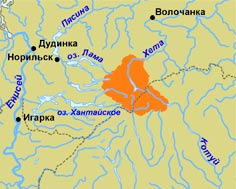How to reach us
117 Uritskogo Str.
Krasnoyarsk, RUSSIA
- e-mail:
- info@sayanring.com
- Open hours:
- Monday-Friday 10 am-7 pm
- Sat 11 am - 4 pm
- Sun - day off
Putorana Plateau
General info
 The most precious component of Middle Siberian nature is basalt highland which is the largest in our country and in 2003 it was added to the list of UNESCO World Heritage Sites in Russia. The Putorana Plateau not only occupies the main part of “Putoransky” Nature Reserve, but also it occupies hearts of those who have seen the banks of purest deep lakes, glaciers on the tops of mountain knaps, who have been breathing the wonderful taiga smell, who have been catching the splashes of the highest waterfalls.
The most precious component of Middle Siberian nature is basalt highland which is the largest in our country and in 2003 it was added to the list of UNESCO World Heritage Sites in Russia. The Putorana Plateau not only occupies the main part of “Putoransky” Nature Reserve, but also it occupies hearts of those who have seen the banks of purest deep lakes, glaciers on the tops of mountain knaps, who have been breathing the wonderful taiga smell, who have been catching the splashes of the highest waterfalls.
The canyons of 1,000 meters deep carve the plateau surface. There are more that 25,000 lakes located at the fringes of plateau, each of them is unique: if we take all the lakes of Putorana and make a puzzle picture of them, then we will get the fresh water reservoir which will be the second in Russia by its water volume after the Lake Baikal. The hydrographers also talk about special Putorana Lake Province which by its water volume is the first among other similar units.
Putorana-Khantaiskoe Lake is the deepest lake at the plateau (former name – Lake Putorana, Kutorana. The plateau was named after the lake). Its depth is 520 meters and the River Khantaika which is a right side stream of Yenisei appears from it. The name of Lake Lama (208 meters deep and a favorite place to spend summer holidays for Norilsk residents) in evenki language means “a big lake” and we must say “the most beautiful and fascinating sight of “Putoransky” Nature Reserve.
Putorana is not only a land of 1,000 lakes but also of 1,000 waterfalls. The waterfalls cluster here in Putorana is the largest in Russia. It is here on river Kyida (Konda) the highest (108 meters) waterfall of Russia is located. The nature itself has created wonderful conditions for such records by its stair-step like valleys. Numerous waterfalls are located at the entries of rivers Khoisa, Bucharama, Dynkenda, Bunisyak (on the west), Oran and Kholokit (on the east). In winter those waterfalls transform to the walls of ice.
Putorana Plateau landscapes are unique by their diversity (Cambridge scientists have approved that fact). Temperature amplitude is approximately 100 degrees (from -69° in winter to +30° in summer) and taking into account the rainfall the Plateau comes before the whole Siberian north region, the reason is the overlapping of subarctic and temperate zones in southern part of the Putorana Plateau. It leads to the great diversity of flora and fauna. The birds which nest on the territory of plateau can be seen almost on all continents (10 species of rare birds – bewicks swan, wood grouse, black crane, merlin, tawny owl, erne, lesser white-fronted goose, goshawk).
The protection of lesser white-fronted goose has a universal importance (the littlest arctic goose in the world). Under-investigated big-horn, thanks to establishing the nature reserve, has moved from the category of endangered species to the category of animal which abundance is steadily growing (now there are more than 6000 animal units). Easily swimming across Yenisei, Pyasina, Khatanga during their seasonal migrations, wild reindeers of Taymyr population (about 480 thousand animal units) crossing the plateau in half a year.
The Putorana plateau is also very popular among ufologists: unusual celestial bodies are seen here very often. They appear in the form of shining fireballs flying at unusual zigzagged courses, also the character of terrestrial magnetic field is very uncommon. SETI has included the Putorana Plateau in the list of 10 UFO-visited places in Russia.
A lot of people are trying to find a “Golden woman” – a legendary wonderworking statue of godhead worshiped by people of North Siberia. People believe that this statue was sent to antiquity from heaven and was able to scream and even could kill with its voice. Closed nature of primeval nooks and protective activities of the nature reserve staff led to the ideal condition of Putorana territory (1887 thousands hectares, buffer zone is 1773 thousands hectares) although it has a “negative” neighborhood – 200 km from west border of the nature reserve there is a Norilsk mining-and-metallurgical integrated works which is a leader at the world market. The land is favorable for researches: at Putorana Plateau the world famous ornithologists, biologists are working at their studies, there are also 4 cordons, several observation stations and a biostation at the Lake Keta.
.png)




.JPG)
.JPG)
.JPG)
